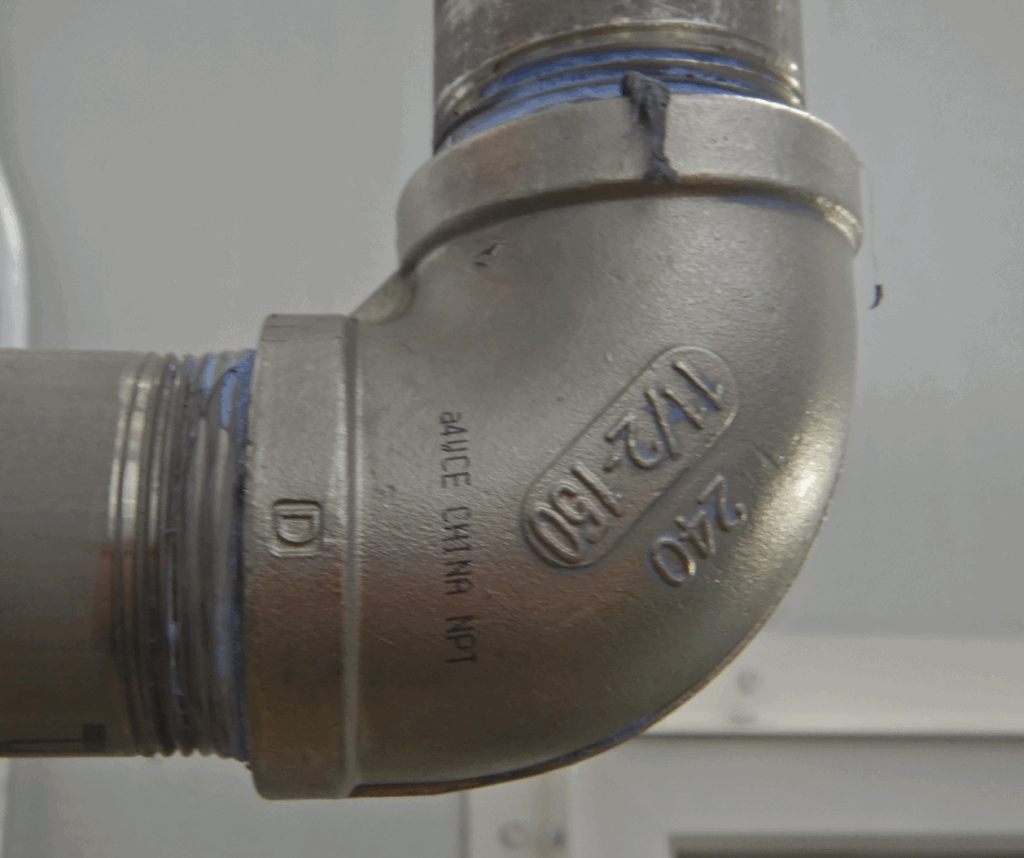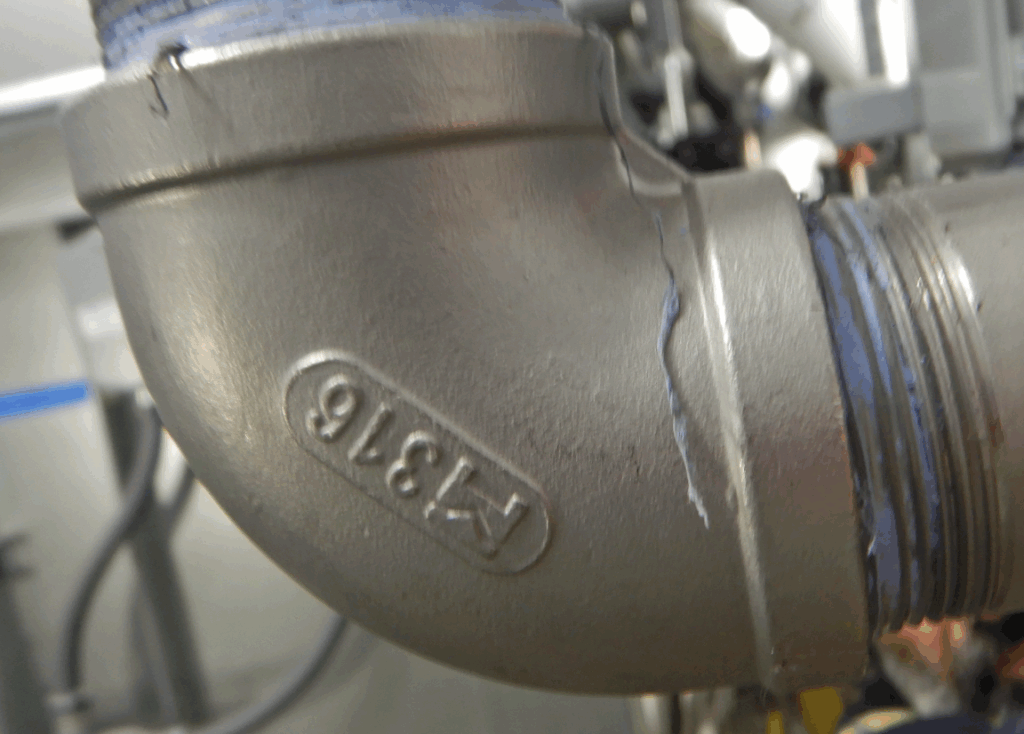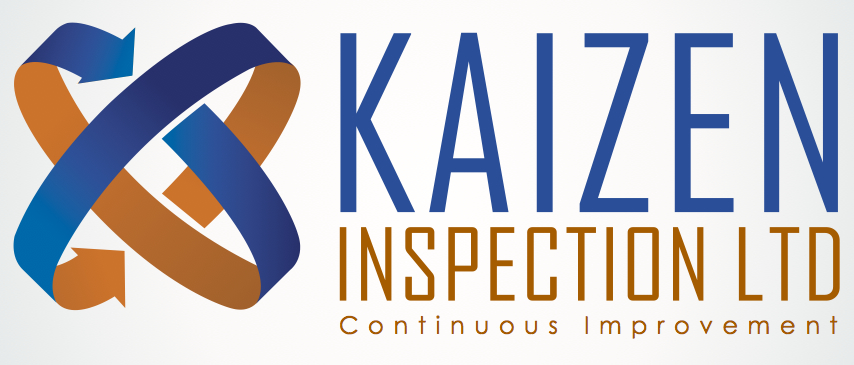In the complex landscape of industrial projects, stainless steel components are frequently used. However, increased vigilance is required when it comes to their compliance with established codes and standards. A persistent and common misconception is that a basic “150 LB” fitting is equivalent to a component that fully complies with the MSS SP-114 specification.
At Kaizen Inspection, we recently encountered a significant compliance ambiguity during a rigorous inspection on a large-scale project. The issue concerned fittings installed in a regulated compressed air network. Although the material appeared to be stainless steel, the absence of the crucial MSS SP-114 marking on certain parts raised critical questions about their actual compliance.
Understanding the Difference: MSS SP-114 vs. 150 LB Fittings
It is essential to clearly understand the distinction between the MSS SP-114 specification and the generic “150 LB” designation. MSS SP-114 defines specific requirements for threaded or socket-weld cast stainless steel fittings, ensuring their strength at given nominal pressures. A “150 LB” fitting—especially of the “light pattern” type—is not automatically compliant with this standard.
Without the SP114 marking, it is impossible to prove compliance, putting the integrity of pressurized systems at risk.
👉 For a more detailed explanation of the difference between “Class 150” and “150 LB,” refer to this technical article by Unified Alloys.



5 Common Mistakes with SP114 Stainless Fittings
- Confusing “150 LB” with SP114 compliance Not all fittings marked “150 LB” comply with MSS SP-114. Many come from looser standards or are “light pattern” fittings.
- Failing to check for the SP114 marking on fittings Without visible SP114 marking, compliance cannot be confirmed, compromising traceability and safety.
- Using materials not listed in the applicable code For example, ASTM A351 is not listed in ASME B31.9, making such fittings non-compliant despite appearing similar.
- Relying solely on supplier documentation Tech sheets and purchase orders do not guarantee conformity if the delivered components differ or lack markings.
- Ignoring engineering or project specifications Some projects strictly require fittings made from ASTM A182. Using alternatives without formal approval leads to non-compliance.
Code Confusion: ASME B31.9 vs. B31.1
Pipe material compliance isn’t defined by a single standard, but rather by the applicable code. ASME B31.9 (Building Services Piping) requires fittings and materials to be listed in its acceptance tables. Neither MSS SP-114 nor ASTM A351 (commonly used for cast stainless fittings) is listed, which means even a SP-114-marked A351 fitting is not compliant under B31.9 unless specifically approved.
In contrast, ASME B31.1 (Power Piping) is more permissive. Clause 923.1.2 – Materials Not Listed allows unlisted materials if they appear in Appendix A. Fortunately, Table A-3 includes ASTM A351 (CF3, CF3M, etc.), meaning cast fittings may be acceptable under B31.1—but not under B31.9 without extra steps.
In the case of theproject, engineering specifications (QRT 1965) explicitly required fittings made of ASTM A182. Any substitution with A351, even marked SP-114, would constitute technical and contractual non-compliance.
Case in Point: The Importance of SP114 Marking
Our inspection revealed multiple fittings lacked the SP114 marking. Although the delivery documentation referenced SP114, there was no formal traceability between the paperwork and the installed fittings. This disconnect raises serious concerns about documentation integrity and regulatory compliance.
The absence of an SP114 marking is a major barrier to verifying compliance. This marking is a direct visual confirmation that the component meets the strict requirements of the standard. At Kaizen Inspection, we emphasize the critical importance of checking for markings on stainless fittings. The presence—or absence—of that small detail can have major consequences for the safety, durability, and code compliance of your installations.
Visual Examples: “Standard Pattern” vs. SP-114 Fittings
- 📄 150LB Standard Pattern Fitting – No SP114 marking
- 📄 150LB MSS SP-114 Certified Fitting – Properly marked
These documents clearly illustrate the difference between common cast stainless fittings and those specifically manufactured to meet SP114 requirements.
📩 Need expert support?
Don’t hesitate to contact Kaizen Inspection for help ensuring your systems meet every technical and code requirement.
